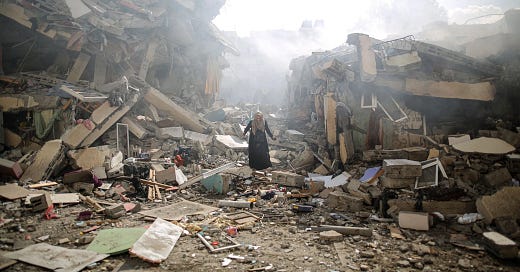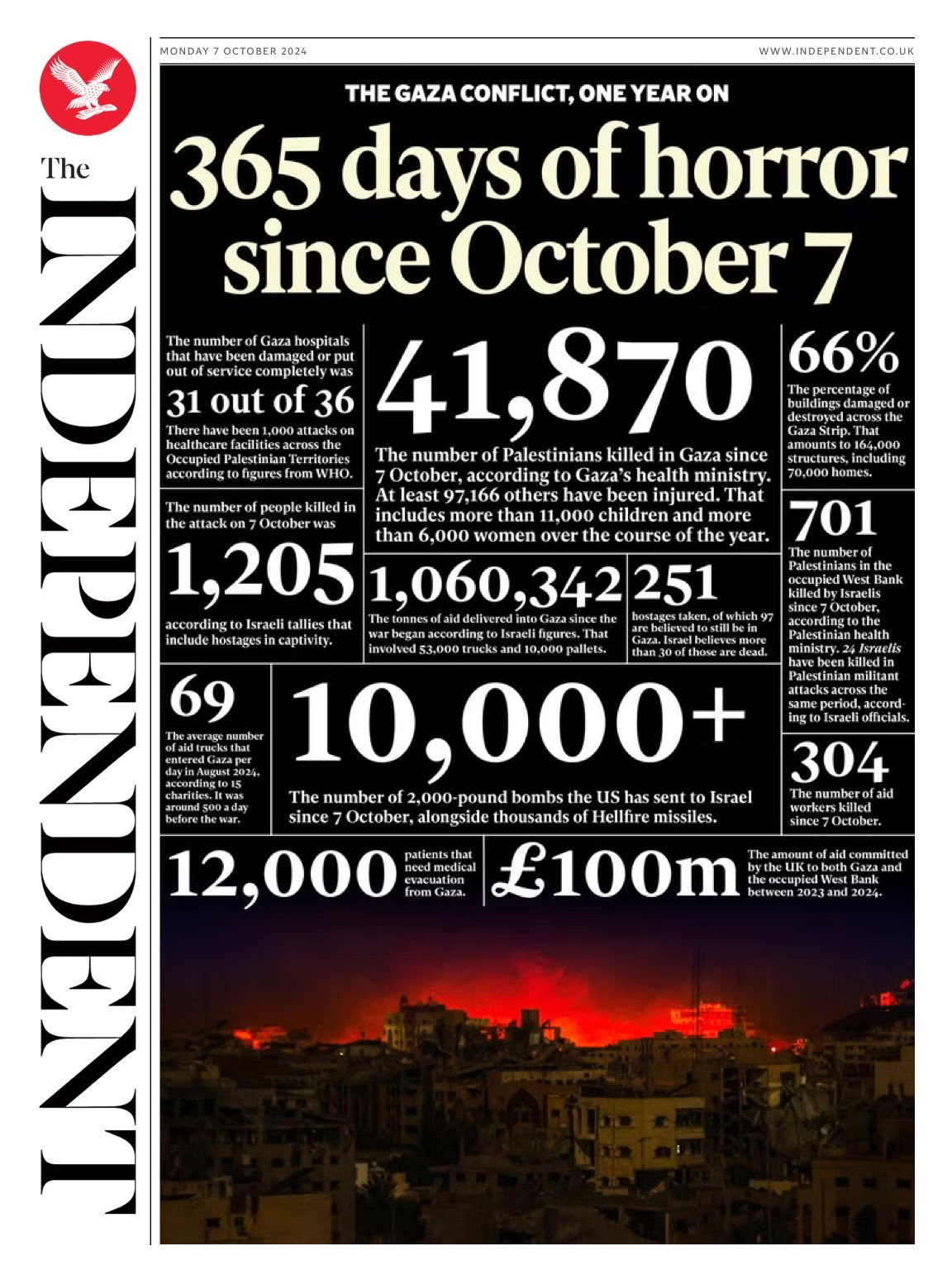Hello, and happy it’s Monday.
This correspondence comes to you on a grim anniversary. One year ago today, Hamas militants breached the security barrier separating the besieged Gaza Strip from Israel and began a rampage that would result in the killing of 1,200 people and the capturing of a further 251 who were taken into Gaza as hostages.
What followed that somber day—the deadliest for Jews since the Holocaust—has been one of the most destructive and brutal military campaigns in modern history. Over the past 12 months, more than 41,500 Palestinians have been killed and more than 96,000 have been wounded under Israeli bombardment—a retaliation so severe that the scars left on Gaza’s terrain are visible from space. The Strip, which was already one of the most densely-populated places on the planet, has since been rendered uninhabitable. Gaza’s infrastructure, including the majority of its buildings, hospitals, and all of its universities, have been destroyed. Nearly 2 million people have been displaced and now languish in tents, where they are tormented by hunger and disease. The lack of sufficient humanitarian aid entering the enclave (roughly 69 trucks per day, down from 500 before the war) has created a persistent risk of famine.
None of this will be unfamiliar to regular readers of this correspondence, of course. Over the past 12 months, I’ve written 50+ stories on the fallout of this war and its impact on the people of Gaza, on Israeli hostages’ families, on journalists, on aid workers, on international law, and on U.S. politics and the upcoming presidential election. Yet no amount of writing will ever feel sufficient enough to capture the extent of loss and despair that so many people are feeling—not just in Israel and Gaza, but in the West Bank and now in Lebanon, where a new and perhaps even more dangerous front of this war has emerged.
For Israelis, today is a day for mourning and remembrance of those killed or abducted a year ago. For Palestinians and the people of Lebanon, however, there is no time for mourning—no reprieve from a war that has, and continues, to upend their world.
What I’ve written
While much of today’s coverage is understandably reflecting on the toll of this past year, I tried to look ahead at what might come next:
What happens next? The so-called “day after” plan, in which Gaza could feasibly be rebuilt and its inhabitants return to their homes, remains as elusive as the ceasefire that would return some 100 remaining hostages to Israel and set the stage for a “day after” to come about. Israeli Prime Minister Benjamin Netanyahu reiterated in a recent interview with TIME his insistence that Israel retain a military presence in the Philadelphi corridor that separates Gaza and neighboring Egypt, which is opposed by Cairo. He has also ruled out the possibility of the Palestinian Authority taking control. Created by the 1993 Accords that were supposed to lead to a Palestinian state, the PA administers only certain parts of the West Bank, which remains under Israeli military occupation. Israel pulled its troops and settlers from Gaza in 2005, though of course its forces are there now.
“Absent a change of policy in Jerusalem, we are sliding into an open-ended occupation of Gaza,” says Nimrod Novik, a fellow at the Israel Policy Forum and the former foreign policy advisor to Israeli Prime Minister Shimon Peres. “Since we are not going to unilaterally withdraw and leave a vacuum for Hamas to recuperate, then it means that we’re going to run Gaza’s affairs for an indefinite future.”
Keep reading: What Lies Ahead for the Middle East
I also interviewed Palestinian journalist Saher Alghorra about his experience documenting the death and destruction in his native Gaza over the past year:
“Covering this war has been difficult and full of risks,” Alghorra says. At least 116 journalists and media workers have been killed doing so since the war began, according to the Committee to Protect Journalists—the deadliest period for journalists since the organization began gathering data in 1992. Alghorra attributes his survival to “God’s kindness and our strong belief that nothing will happen to us except what God has written for us.” Still, he says the fear of death follows him everywhere. “We have become numb.”
Keep reading: A Palestinian Photographer Reflects on One Year of Life and Death in Gaza
Plus:
For the TIME100 Next list, I penned a brief profile of Palestinian food blogger Hamada Shaqoura, who is using what limited ingredients get into Gaza in order to create meals for “the children of the tents.”
For the same list, I also wrote about the leaders of Israel’s largest Arab-Jewish grassroots movement, Standing Together, which is fighting for peace, equality, and social justice for everyone in Israel-Palestine.
What I’ve read
Joe Biden Chose This Catastrophic Path Every Step of the Way • By Matthew Duss in The New Republic
In public the Biden administration seemed to be watching a completely different war, pretending not to see the mounting atrocities that everyone in the world with a smartphone could plainly see, offering occasional kind words for international law and the protection of civilians with all the heft of the “thoughts and prayers” offered by Republican members of Congress after school shootings. On the ground, Biden deferred to Israeli preferences and practices in almost all cases, no matter the clear humanitarian impact. The mass killing and displacement of civilians, which would be condemned in the harshest possible terms were it being done by an adversary, and in fact has been so condemned when done by Russia in Ukraine, has been treated like the weather. Simply nothing to be done. Pass the ammunition.
The War That Would Not End • By Franklin Foer in The Atlantic
Dermer said that he would get to work on it. But throughout October, Biden-administration officials kept finding themselves struck by the Israeli government’s unwillingness to explore hostage negotiations. Perhaps it was just the chaos that reigned in the aftermath of the attacks, but they began to feel as if there was a stark difference in outlook: Where the Americans were prepared to negotiate with Hamas, the Israelis wanted to obliterate it. Where the Americans worried about hostages dying in captivity, Israel retained confidence in its ability to stage daring rescues.
The Return of Ta-Nehisi Coates • By Ryu Spaeth in New York Magazine
There are, of course, many who believe that the moral dimensions of the Israeli-Palestinian conflict are indeed complicated. The most famous of Israel’s foundational claims — that it was a necessary sanctuary for one of the world’s most oppressed peoples, who may not have survived without a state of their own — is at the root of this complication and undergirds the prevailing viewpoint of the political-media-entertainment nexus. It is Israel’s unique logic of existence that has provided a quantum of justice to the Israeli project in the eyes of Americans and others around the world, and it’s what separates Jewish Israelis from the white supremacists of the Jim Crow South, who had no justice on their side at all. But for Coates, one wrong cannot justify another. “All states at their core have a reason for existing — a moral story to tell,” he told me. “We certainly do. Does industrialized genocide entitle one to a state? No.” Especially, he said, at the expense of people who had no hand in the genocide.
What I’m thinking about
A couple of weeks ago, I attended a screening of Oscar-nominated filmmaker Farah Nabulsi’s latest project, The Teacher, which offers a compelling and timely depiction of life under Israeli occupation in the West Bank. The film is already out in cinemas in the U.K. and Ireland, and is due to be released on Netflix in the U.S. next year.
You can watch the trailer here.
Until next time,
Yasmeen






